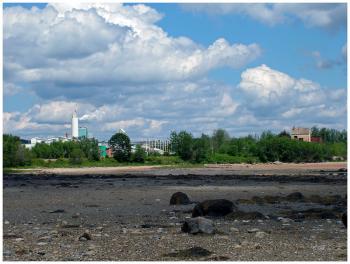Baywatchers challenge Searsport company to curb pollution legacy
SEARSPORT - The beachcombers had come expecting to see signs of pollution, but the first one — a bright yellow object, the size and shape of a date — seemed to catch most of them off guard.
They formed a circle around it. The cameras came out. Someone asked the inevitable question.
Ron Huber, who organized the walk under the banner of Friends of Penobscot Bay, guessed that it was largely sulphur. Not a sulphur-colored stone, but a lump of some sulphur compound.
Someone picked it up and sniffed it.
Over an eroded bluff could be seen the tops of buildings used by GAC Chemical Corp. The company owns a mile-long stretch of coastline that bows out into Stockton Harbor at Kidder Point. Approaching from the east, the beach curves off to the right. Straight ahead was an abandoned building and storage tank left over from some bygone industry and suspected of contributing to a slow release of pollutants into Penobscot Bay.
The building predates GAC’s acquisition of the property from Delta Chemical in 1994, but it sits on the company’s land. So, what to do?
Friends of Penobscot Bay wants the company to demolish it, find out what’s underneath and take a variety of other actions to stop toxic materials from leaching into Penobscot Bay. And they want the company to do it voluntarily.
Unlike the classic meetings of environmentalists and industrialists, Huber and Friends of Penobscot Bay president Harlan McLaughlin have a good feeling toward GAC.
The company makes chemicals used in the pharmaceutical, food and water treatment industries, and is a distributor in New England for a variety of chemicals, some used in fertilizers.
GAC has a good enviromental record for its own operations, and in Huber’s words has served as “an example of responsible industrial manufacturing.”
But the property on which GAC sits has long history of less-responsible manufacturing, including the disposal of industrial byproducts along the eroding shoreline.
Recent aerial photos show a plume of discolored mud originating near the abandoned brick building and storage tank on Kidder Point.
“We don’t know what’s coming out of it but something’s coming out,” Huber said.
Maine Department of Environmental Protection cited GAC in 1998 for multiple violations related to high acidity runoff from the property. The Department of Marine Resources made recommendations at that time to stabilize the shoreline to prevent the erosion of contaminated soil.
According to a former GAC plant operator, the shoreline had deposits of bauxite — an acidic ore byproduct — along with sulfur, carbon and other materials related to fertilizer and chemical manufacturing between 1939 and 1970.
Huber included aluminum on the list — the “a” in GAC is for alum, typically aluminum sulfate — and portions of the waterfront property were historically a dumping ground for alum tailings, sometimes near the shore.
Aluminum can cause “plating” on the gills of plankton and fish, Huber said, which inhibits their breathing.
“Suddenly, they’ll feel like they’ve been chain smokers their whole lives,” he said.
Whether this is happening or not, Huber doesn’t know for sure. Dead fish aren't piling up on the beach, but the changes brought by pollution aren’t always so dramatic.
Huber noted that Stockton Harbor should have a strong recreational fishing stock but it doesn’t.
“It’s a fairly barren environment in there and it shouldn’t be,” he said. “So you try to look at what’s the problem?”
Further up the beach there were more lumps of sulphur. Most were smaller than a child’s fist, but occasionally a larger one would turn up. At least one was the size of a football.
Increasingly the rocks of the beach were mixed with discarded building materials: bricks, ceramic gears, massive slabs of concrete and rebar. In places the sand was an iron oxide red with patches of a creamy light gray.
The group wants to see three things happen: for GAC to follow the 1998 DMR recommendations and stabilize the shoreline; to have the soil and water tested to determine what chemicals are present; and to see the abandoned brick building and tank from which the plume seem to originate demolished in order to find out what’s underneath it.
The timing of the demands comes on the heels Searsport plant operator David Colter’s promotion to President and CEO of GAC.
“We’re telling him, now’s your chance. You’re the big dog,” Huber said. “We don’t want to make them out as bad guys. As far as the community is concerned, they’re good guys.”
If GAC does a voluntary cleanup, Huber and McLaughlin believe it would go a long way toward convincing other small manufacturers in the area to do the same.
According to Huber and McLaughlin, Colter has been receptive but nothing has happened yet. The activists say several of the CEO’s self-imposed deadlines for starting remediation have come and gone with no action. Colter was reportedly out of town on the day of the beach walk.
“He responds and he’s nice and he’s real cordial, but…” McLaughlin said, pausing and making a come-along gesture with his hand. “You have to go to the next step.”
“We’d just as soon praise them for doing the right thing,” Huber said.
The alternative, he said, is taking the company to court.
Near the beach, a dozen-or-so gulls floated in the shallows. Occasionally one would pick something from below the surface of the water. Huber guessed mussels.
“It’s not a complete disaster area,” he said. “They just need to do a few things.”
Ethan Andrews can be reached at news@penbaypilot.com




























